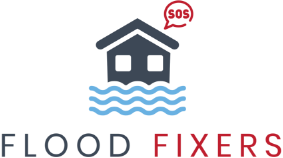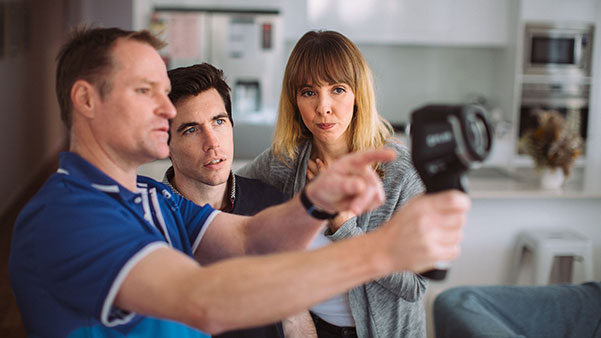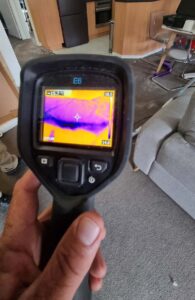How is thermal imaging utilised in water damage restoration jobs!
Thermal imaging is a tool commonly used on water damage restoration jobs to assist with locating water and moisture inside a water damaged house or commercial building. Thermal imaging is a fast and reliable way to ensure all the moisture is identified on recently water damaged properties.
Often moisture in a water damaged building or home can be invisible to the naked eye, therefore without thermal imaging it is not possible to truly know the full extent of the water damage. Thermal imaging will detect moisture on all types of materials including:
- Wet gyprock walls and inside wall cavities.
- Wet carpets and all types of wet flooring.
- Wet ceilings and inside roof cavities.
- Water affected cabinetry.
- Wet wall and ceiling insulation.
- Water affected floating floors.
- Concrete slabs and sub-floors.
- Wet timber flooring and timber sub-floors.
- Tiled flooring and tiled walls.
- Wet timber wall frames.
Utilising thermal imaging for moisture mapping.
A professional water damage restorer will often implement thermal imaging when moisture mapping a water affected property. Moisture mapping is a process used in the water damage restoration industry to outline and pinpoint exactly where there is moisture within the water affected property to determine exactly which areas need to be structurally dried due to the water damage event.
Thermal imaging will also indicate the level of moisture within the water affected materials, this information is vital to the water damage restorer and will assist with the overall water damage restoration process.
Thermal imaging is not only extremely accurate it is also an extremely fast way to moisture map a property and especially useful when dealing with large water damaged area. The images from the thermal imaging can also be easily captured and downloaded into water damage reporting systems.
- Fast and accurate for moisture mapping
- Can indicate the level of moisture in wet materials.
- Extremely useful for moisture mapping large areas.
- The images can be downloaded into water damage reporting systems.
Utilising thermal imaging for water damage assessments.
Thermal imaging is often implemented by the professional water damage restorer when conducting water damage assessments. Again, this is very useful, and the thermal imaging can detect and locate the hidden moisture inside the wall cavities and underneath any wet flooring.
This is especially useful as the restorer can easily show the customer the full extent of the water damage including all of the hidden and trapped moisture that can be inside wall cavities and underneath flooring.
When conducting a water damage assessment, the customer is always very impressed with the technology, and often surprised to see just how much their property has actually been impacted by the water damage event.
Thermal imaging shows the real picture of the water damage and will locate even the smallest amount of hidden and trapped moisture inside a water damage house or business premises.
Thermal imaging for leak detection.
Whilst thermal imaging is not a leak detection instrument, if used properly thermal imaging can also be very handy for locating and tracking down the source of water leaks inside a water damaged house or a water damaged commercial building.
Often water leaks inside a water damaged house or a water damaged commercial building will originate inside wall cavities, making it difficult to find the source of the water leak. Thermal imaging can identify the moisture hotspot within the property giving the technician a good indication of the actual source of the water leak.
Thermal imaging can even track the path of the moisture that has resulted from the water leak, this moisture is all invisible to the human eye and known of this is possible without thermal imaging technology.
Thermal imaging for water damage is a useful tool to have.
A high-quality thermal imaging camera is an extremely useful tool for the professional water damage restorer to have. Having the latest thermal imaging technology will give the restorer confidence in know that he or she has every chance of producing a very successful water damage restoration outcome for their valued customer.
The water damage restorer will implement this thermal imaging technology on a wide variety of jobs and for a whole range of uses. It’s fair to say that thermal imaging is a must have tool for all water damage restorers to have in their service vehicles.
- Moisture mapping.
- Flooded house evaluation.
- Water damage assessments.
- Mould remediation assessments.
- Locating trapped and hidden moisture.
- Determining moisture levels in flooded houses and buildings.
- Commercial water damage evaluations.
- Locating and detecting leaks.
Flood Fixers – Utilise the latest thermal imaging for water damage restoration in Adelaide.
The handy team at Flood Fixers have been professionally trained and accredited in the correct procedures for advanced thermal imaging. Using the very latest, most advanced thermal imaging our expert team can track down and located even the smallest amount of hidden moisture in water damaged houses in Adelaide.
Our friendly team implement thermal imaging for a whole range of reasons from moisture mapping commercial properties right through to conducting water damage assessments in Adelaide houses.
If you require specialised thermal imaging or any type of water damage restoration service in Adelaide, call our friendly team anytime, we are here to help our valued customers around the clock 24/7.
At Flood Fixers we value all kinds of communication, so if you are stressed and facing a water damage disaster in Adelaide and you require some obligation free advice, please feel free to contact us anytime, we are always here to help as much as we can.
- Latest Thermal imaging & moisture readings.
- Water damage assessments Adelaide wide.
- Moisture mapping and location of hidden moisture.
- Leak detection and moisture tracking
- Flooded house evaluation.
Flood Fixers Adelaide water damage service areas include:
All Adelaide suburbs
Adelaide Hills.
Fleurieu Peninsular.
Barossa Valley.
Murray Bridge.






